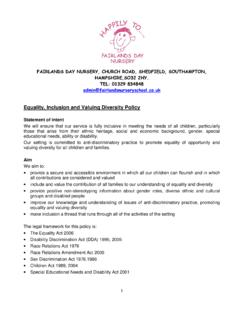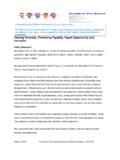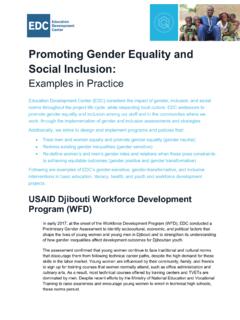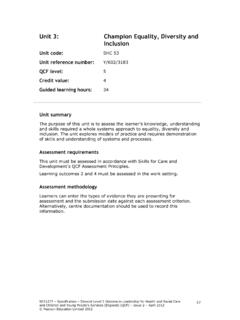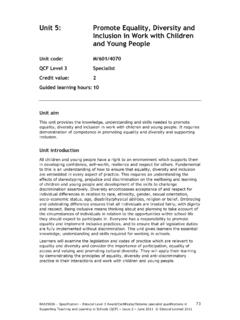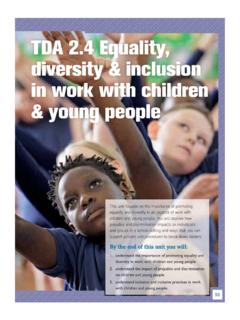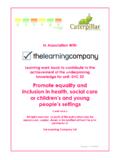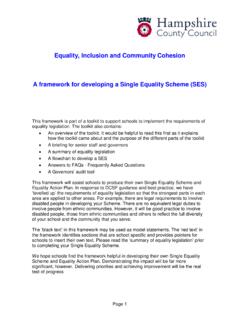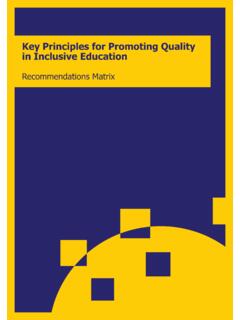Transcription of Equality Diversity and Inclusion Policy - A.F. Blakemore
1 A F Blakemore and Son Ltd 1 Equality , Diversity and Inclusion Policy 1. Underlying Principle A F Blakemore appreciates that everyone is different and has something unique to offer and wants to respect and understand these differences and to make the most of everyone s talents. The company will actively promote equal opportunities throughout the business. The company s commitment to ensure Equality , Diversity and Inclusion is: To promote an inclusive culture for all our staff, others who work with us, and the communities that we serve. To provide opportunities that are accessible and appropriate for everyone. To provide organisational capability for continuous improvement, learning and sharing good practice. To work towards the elimination of all forms of discrimination and harassment. To positively promote Equality throughout all our activities and communications. To create an environment in which individual differences and the contributions of all our employees and stakeholders are recognised and valued.
2 To create a working environment that promotes dignity and respect for all. No form of intimidation, bullying or harassment will be tolerated. To ensure training, development and progression opportunities are available to all. To regularly review all employment practices and procedures to ensure that no job applicants, employees or stakeholders are treated less favourably than others. To treat breaches of the Equality Policy seriously and to take disciplinary action when required. To provide information and training to all employees so that they are fully aware of the issues relating to Equality , Diversity & Inclusion , and their responsibilities relating to it. To ensure our Equality , Diversity & Inclusion Policy is fully implemented. To monitor and review the Policy annually The company will ensure that everyone is respected and can give of their best, irrespective of who they are or what job they do.
3 Staff with management, recruitment and selection and/or training responsibilities will be given guidance in the implementation of the Equality , Diversity and Inclusion Policy to ensure that they understand the company s objectives and commitments as well as their own position in law. 2. Definitions Equality is about managing differences so that everyone has Equality of opportunity through a fair and consistent approach to the application of rules, policies and procedures. The company recognises that sometimes this will mean treating people differently. This commitment is relevant to all we do, how we manage ourselves and how we deliver service to our customers. A F Blakemore and Son Ltd 2 Diversity is about understanding, recognising, respecting and valuing differences. It means understanding that each individual is unique, and recognising our individual differences. These can be along the dimensions of race, ethnicity, gender, sexual orientation, socio-economic status, age, physical abilities, religious beliefs, political beliefs, or other ideologies.
4 It is the exploration of these differences in a safe, positive, and nurturing environment. It is about understanding each other and moving beyond simple tolerance to embracing and celebrating the rich dimensions of Diversity contained within each individual and how this can positively impact on our culture and values as well as our understanding of the communities we serve. Inclusion is about attracting and developing talent wherever it exists and encouraging everyone in our business to reach their full potential in whatever they do. It is about ensuring our policies, procedures and processes are relevant to all. It is about ensuring wider business communications are cascaded throughout all divisions to allow employees to engage with the company they work for. It is about valuing every individual contribution towards the company s objectives. 3. Leadership and management The Board takes overall responsibility for the development of Equality , Diversity and Inclusion through leading by example and ensuring that progress is reviewed and further actions instigated as necessary.
5 All A F Blakemore leaders and managers at all levels will demonstrate their commitment to promoting Equality , Diversity and Inclusion , and take responsibility for progress, and all staff have personal responsibilities to treat everyone with respect, consideration and without prejudice and to promote the same levels of behaviour in colleagues. Leaders and managers visibly: a) Challenge unacceptable behaviours and create a climate where complaints can be raised without the fear of reprisal b) Take firm action where unfairness or inconsistency exists c) Encourage and support Diversity and Inclusion within their teams d) Demonstrate and promote considerate and fair behaviour e) Treat staff with dignity and respect and recognise and value individual skills and contributions f) Demonstrate through words and actions that Diversity is an integral part of meeting the business priorities g) Create an environment in which staff are able to identify and share good practice, celebrate success and encourage positive attitudes towards Diversity A F Blakemore and Son Ltd 3 4.
6 Communication We will ensure that this Policy is accessible and understood by everyone in A F Blakemore . Getting our message across successfully means all staff will: a) Be aware of A F Blakemore policies on Equality , Diversity and Inclusion b) Understand the benefit of valuing Diversity and how this impacts on the company c) Have a greater awareness of the value of more inclusive communication d) Understand their own role in promoting Equality , Diversity and Inclusion e) Be aware of their legal responsibilities under current Equality legislation 5. Discrimination It is against the law to discriminate directly or indirectly in recruitment or employment because of age, disability, sex, gender reassignment, pregnancy or maternity, race (which includes colour, nationality and ethnic or national origins), sexual orientation, religion or belief, or because someone is married or in a civil partnership. These are known as "protected characteristics , within The Equality Act 2010.
7 We will also not discriminate because of working patterns or trade union membership nor will we tolerate harassment or bullying on these or any other grounds. 6. Discrimination Definitions: Direct discrimination is where a person is treated less favourably than another because of a protected characteristic. An obvious example of direct discrimination would be refusing to employ a woman because she is pregnant. In limited circumstances, we can directly discriminate against an individual for a reason related to any of the protected characteristics where there is an occupational requirement. However the occupational requirement must be crucial to the role and a proportionate means of achieving a legitimate aim. Indirect discrimination is where a provision, criterion or practice is applied that is discriminatory in relation to those who have a relevant protected characteristic (although it does not explicitly include pregnancy and maternity, which is covered by indirect sex discrimination) so that its application would be detrimental to people who share that protected characteristic compared with people who do not, and it cannot be shown to be a proportionate means of achieving a legitimate aim.
8 Associative discrimination is where an individual is directly discriminated against or harassed for association with another individual who has a protected characteristic (although it does not cover harassment because of marriage and civil partnership, and pregnancy and maternity). A F Blakemore and Son Ltd 4 Perceptive discrimination is where an individual is directly discriminated against or harassed based on a perception that he/she has a particular protected characteristic when he/she does not, in fact, have that protected characteristic (other than marriage and civil partnership, and pregnancy and maternity). Victimisation occurs where an employee is subjected to a detriment, such as being denied a training opportunity or a promotion because he/she made or supported a complaint or raised a grievance under the Equality Act 2010, or because he/she is suspected of doing so. For example, if a blind employee raises a grievance that the employer is not complying with its duty to make reasonable adjustments, and is then systematically excluded from all meetings, such behaviour could amount to victimisation.
9 However, an employee is not protected from victimisation if he/she acted maliciously or made or supported an untrue complaint. Failure to make reasonable adjustments is where a physical feature or a provision, criterion or practice puts a disabled person at a substantial disadvantage compared with someone who does not have that protected characteristic and the employer has failed to make reasonable adjustments to help enable the disabled person to overcome the disadvantage. 7. Dignity at Work Harassment at work A F Blakemore is committed to ensure that no harassment or victimisation at work, whatever the motivation, is over-looked or condoned. Such behaviour can range from extreme forms such as violence or bullying to less obvious actions like practical jokes and ridiculing managers, colleagues or subordinates. The law defines harassment as unsolicited and unwelcome workplace behaviour that has the purpose or effect of violating the dignity of the recipient or creating an intimidating, hostile, degrading, humiliating or offensive environment for the recipient.
10 Where such behaviour is motivated by Age, Race, Sex, Gender Reassignment, Disability, Sexual Orientation, Religion or Belief, Pregnancy or Maternity and Civil Partnership or Marriage it also amounts to an infringement of equal employment opportunity. Conduct becomes harassment if it persists after the recipient has made clear that it is regarded as offensive, although a single offensive act can amount to harassment if it is so serious as to be obviously offensive towards the recipient. Any form of harassment is a potential disciplinary matter and may be regarded as gross misconduct. The following examples illustrate the sort of conduct that may be treated as harassment; unwanted physical contact, or conduct that is intimidating, the display of inappropriate material, or physical or verbal abuse. Harassment can also be non-verbal, for example, staring, gestures, ignoring or isolating somebody in the workplace.
